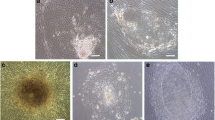Abstract
Stem cell culture systems that rely on undefined animal-derived components introduce variability to the cultures and complicate their therapeutic use. The derivation of human embryonic stem cells and the development of methods to produce induced pluripotent stem cells combined with their potential to treat human diseases have accelerated the drive to develop xenogenic-free, chemically defined culture systems that support pluripotent self-renewal and directed differentiation. In this chapter, we describe four xeno-free culture systems that have been successful in supporting undifferentiated growth of hPSCs as well as methods for xeno-free subculture and cryopreservation of hPSCs. Each culture system consists of a xeno-free growth medium and xeno-free substratum: (1) TeSR2™ with human recombinant laminin (LN-511); (2) NutriStem™ with LN-511; (3) RegES™ with human foreskin fibroblasts (hFFs); (4) KO-SR Xeno-Free™/GF cocktail with CELLstart™ matrix.
Access this chapter
Tax calculation will be finalised at checkout
Purchases are for personal use only
Similar content being viewed by others
References
Thomson JA, Itskovitz-Eldor J, Shapiro SS, et al. (1998) Embryonic stem cell lines derived from human blastocysts. Science;282:1145–7.
Reubinoff BE, Pera MF, Fong CY, Trounson A, Bongso A. (2000) Embryonic stem cell lines from human blastocysts: somatic differentiation in vitro. Nat Biotechnol;18:399–404.
Koivisto H, Hyvarinen M, Stromberg AM, et al. (2004) Cultures of human embryonic stem cells: serum replacement medium or serum-containing media and the effect of basic fibroblast growth factor. Reprod Biomed Online;9:330–7.
Inzunza J, Gertow K, Stromberg MA, et al. (2005) Derivation of human embryonic stem cell lines in serum replacement medium using postnatal human fibroblasts as feeder cells. Stem Cells;23:544–9.
Richards M, Fong CY, Chan WK, Wong PC, Bongso A. (2002) Human feeders support prolonged undifferentiated growth of human inner cell masses and embryonic stem cells. Nat Biotechnol;20:933–6.
Hovatta O, Mikkola M, Gertow K, et al. (2003) A culture system using human foreskin fibroblasts as feeder cells allows production of human embryonic stem cells. Hum Reprod;18:1404–9.
Unger C, Gao S, Cohen M, et al. (2009) Immortalized human skin fibroblast feeder cells support growth and maintenance of both human embryonic and induced pluripotent stem cells. Hum Reprod. Oct;24(10):2567–81. Epub 2009 Jun 25.
Yu J, Vodyanik MA, Smuga-Otto K, et al. (2007) Induced pluripotent stem cell lines derived from human somatic cells. Science;318:1917–20.
Unger C, Felldin U, Nordenskjold A, Dilber MS, Hovatta O. (2008) Derivation of human skin fibroblast lines for feeder cells of human embryonic stem cells. Curr Protoc Stem Cell Biol;Chapter 1:Unit 1 C 7.
Unger C, Skottman H, Blomberg P, Dilber MS, Hovatta O. (2008) Good manufacturing practice and clinical-grade human embryonic stem cell lines. Hum Mol Genet;17:R48-53.
Carpenter MK, Rosler E, Rao MS. (2003) Characterization and differentiation of human embryonic stem cells. Cloning Stem Cells;5:79–88.
Montes R, Ligero G, Sanchez L, et al. (2009) Feeder-free maintenance of hESCs in mesenchymal stem cell-conditioned media: distinct requirements for TGF-beta and IGF-II. Cell Res;19:698–709.
Watanabe K, Ueno M, Kamiya D, et al. (2007) A ROCK inhibitor permits survival of dissociated human embryonic stem cells. Nat Biotechnol;25:681–6.
Martin-Ibanez R, Unger C, Stromberg A, Baker D, Canals JM, Hovatta O. (2008) Novel cryopreservation method for dissociated human embryonic stem cells in the presence of a ROCK inhibitor. Hum Reprod;23:2744–54.
Ellerstrom C, Strehl R, Noaksson K, Hyllner J, Semb H. (2007) Facilitated expansion of human embryonic stem cells by single-cell enzymatic dissociation. Stem Cells;25:1690–6.
Rajala K, Hakala H, Panula S, et al. (2007) Testing of nine different xeno-free culture media for human embryonic stem cell cultures. Hum Reprod;22:1231–8.
Rajala K, Lindroos B, Hussein SM, et al. (2010) A defined and xeno-free culture method enabling the establishment of clinical-grade human embryonic, induced pluripotent and adipose stem cells. PLoS One;5:e10246.
Akopian V, Andrews PW, Beil S, et al. (2010) Comparison of defined culture systems for feeder cell free propagation of human embryonic stem cells. In Vitro Cell Dev Biol Anim;46:247–58.
Holm F, Strom S, Inzunza J, et al. (2010) An effective serum- and xeno-free chemically defined freezing procedure for human embryonic and induced pluripotent stem cells. Hum Reprod;25:1271–9.
Acknowledgments
Our hESC and iPSC culture optimization studies have been supported by EU: ESTOOLS, ISCI2, the Swedish Research Council, and the R&D Funds (ALF) of Stockholm County and Karolinska Institute and KID funds of Karolinska Institute. Special Note: Outi Hovatta is a patent holder of the RegES medium.
Author information
Authors and Affiliations
Corresponding author
Editor information
Editors and Affiliations
Rights and permissions
Copyright information
© 2011 Springer Science+Business Media, LLC
About this protocol
Cite this protocol
Bergström, R., Ström, S., Holm, F., Feki, A., Hovatta, O. (2011). Xeno-Free Culture of Human Pluripotent Stem Cells. In: Schwartz, P., Wesselschmidt, R. (eds) Human Pluripotent Stem Cells. Methods in Molecular Biology, vol 767. Humana Press. https://doi.org/10.1007/978-1-61779-201-4_9
Download citation
DOI: https://doi.org/10.1007/978-1-61779-201-4_9
Published:
Publisher Name: Humana Press
Print ISBN: 978-1-61779-200-7
Online ISBN: 978-1-61779-201-4
eBook Packages: Springer Protocols




